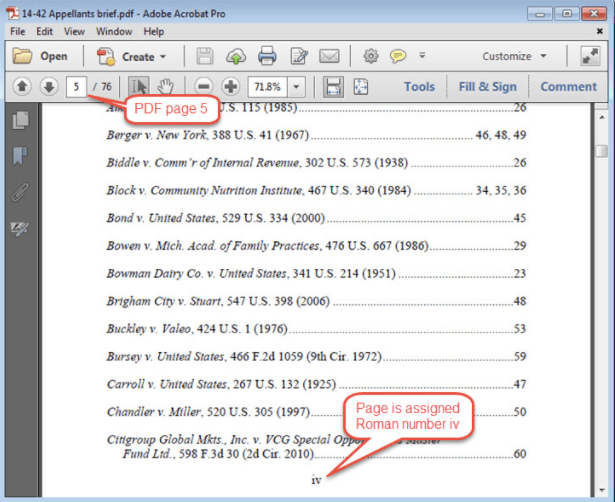Habits of a lifetime are hard to break.
One such habit in the legal profession has been to paginate certain prefatory sections of court filings using Roman numerals. It’s what we’ve always done.
Well, as with so many other long-term law office habits, the introduction of electronic court filing means that this is a habit that you’re going to have to break.
The state courts (from Texas to Indiana, and — since 1 January 2017 — California, too) have now followed the federal courts in requiring consecutive pagination, in Arabic numerals, for the entire filing. This includes tables of contents and authorities that were previously in Roman numerals and exhibits that perhaps weren’t numbered at all.
The website of the U.S. Second Circuit neatly explains why pagination matters when eFiling:
“Any person viewing a PDF [filing] must be able to enter a page number in the page search field on the tool bar or ‘Go To Page’ field under ‘View’ and have that number match the page number displayed in the filer’s PDF.”
Here’s an example from the Second Circuit of an incorrectly paginated filing:

eFiling pagination requirements in the state courts
Now that the state courts are beginning to require electronic filing they’re encountering the same problem that the federal courts have been dealing with for a long time. The result is that most state courts have introduced new rules relating to pagination.
California
Beginning January 1, 2017, California introduced a new state rule governing pagination of “papers,” motion documents, and motion memoranda — rules 2.109, 3.1110(c), and 3.1113(h). It provides that page numbering must begin with the first page and use only Arabic numerals (e.g. 1, 2, 3). Numbering must start with the first page and be consecutive throughout the entire document.
The Judicial Council noted, however, that numbering pages in this way does not effect the maximum allowable page counts. It noted in its committee report on the rule change that:
“To ensure that the amendment to rule 3.1113(h) would not alter the number of pages allowed for memoranda, this proposal would also amend rule 3.1113(d) by providing that the caption page and the notice of motion and motion are not counted in determining whether a memorandum exceeds the page limit. Subdivision (d) already provides that exhibits, declarations, attachments, the table of contents, the table of authorities, and the proof of service are not counted.“
Since January, we have received several queries asking whether exhibits need to be consecutively numbered. To help get to the bottom of this, we reached out to Julie Goren, author of the book Litigation by the Numbers and a guru in all things court rule related.
She confirmed that, in her reading, the rule requires all pages of a filing — exhibits included — to be consecutively numbered. This, she says, is the logical conclusion given that the court’s objective is for the page number of the document to match the page number of the PDF.
Texas
The Texas courts have long taken the exact same approach to pagination. The state’s digital media standards are clear:
“Documents must contain complete page numbering for the entire filing. When including one or more appendices to a filing, either 1) number appendices individually and then number the entire document as a whole, or 2) number the entire document as a whole including appendices.”
Indiana
Indiana, too, has stipulated that the entire submission must be consecutively numbered in Arabic numerals. The state’s rules require that eFiled documents (motions, petitions, briefs, appendices, addenda, etc.) be numbered with page “1” being the first page, and all pages consecutively numbered after that.
Page numbering on exhibits
It’s best practice, therefore, to add a footer to all pages — exhibits, too — to display the page number. What if your exhibit already contains page numbers, for example, if as an original letter or document it was page numbered?
In these circumstances, retain the original page numbers and position the new footer such that the page numbers for the entire document are visible and not obscuring the originals.
There’s more advice on creating a court-friendly PDF in our free downloadable guide:








